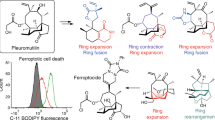Abstract.
Four novel proteins (phoratoxins C–F) have been isolated from the North American mistletoe Phoradendron tomentosum. The amino acid sequences of these phoratoxins were determined unambiguously using a combination of Edman degradation and trypsin enzymatic digestion, and by electrospray ionization tandem mass spectrometry sequencing. Phoratoxins C, E and F consist of 46 amino acid residues; and phoratoxin D of 41. All proteins had six cysteines, similar to the earlier described phoratoxins A and B, which are thionins. The cytotoxicity of each protein was evaluated in a human cell line panel that represented several cytotoxic drug-resistance mechanisms. For the half-maximal inhibitory concentrations (IC50 values) of the different cell lines in the panel, correlation with those of standard drugs was low. The most potent cytotoxic phoratoxin C was further tested on primary cultures of human tumor cells from patients. The solid tumor samples from breast cancer cells were 18 times more sensitive to phoratoxin C than the tested hematological tumor samples.
Similar content being viewed by others
Author information
Authors and Affiliations
Additional information
Received 30 September 2002; received after revision 28 October 2002; accepted 7 November 2002
RID="*"
ID="*"Corresponding author.
Rights and permissions
About this article
Cite this article
Johansson, S., Gullbo, J., Lindholm, P. et al. Small, novel proteins from the mistletoe Phoradendron tomentosum exhibit highly selective cytotoxicity to human breast cancer cells. CMLS, Cell. Mol. Life Sci. 60, 165–175 (2003). https://doi.org/10.1007/s000180300011
Issue Date:
DOI: https://doi.org/10.1007/s000180300011




